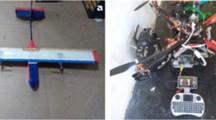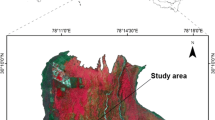Abstract
The biomass content of vegetation has great significance for efficient balancing of biomass cycle. Estimation of biomass in vegetation requires quantification of tree canopy. Automatic extraction of tree canopy helps in faster and efficient estimation of the biomass content of a vegetative area in comparison to manual mapping methods. An agricultural farm at Papparapati Village in Dharmapuri, District, Tamil Nadu, with an Area of 1.2 sq.km was chosen as study area and multispectral UAV imagery at 4-cm spatial resolution with 4 Bands viz., NIR, Green, Red Edge, RED was acquired. In this study, an attempt has been made to automatically extract tree canopy using simple deep learning convolution neural network (CNN) using training sites as input from the band spectral information. The extracted tree canopy was refined using linear cluster algorithm to delineate the exact tree crown. The biomass of the tree is estimated using the tree properties (crown diameter, height) derived from UAV data and using the allometric equations. A field survey was conducted to validate the classification results achieved from UAV data of individual sample trees. It is observed that the accuracy of extracted tree properties was in agreement with the field measurements of sample trees.







Similar content being viewed by others
References
Angelsen, A. (2008). Moving ahead with REDD: Issues, options and implications. Bogor, Indonesia: Center for International Forestry Research (CIFOR).
Barrett, F., Mcroberts, R., Tomppo, E., Cienciala, E., & Waser, L. (2016). A questionnaire-based review of the operational use of remotely sensed data by national forest inventories. Remote Sensing of Environment, 174, 279–289. https://doi.org/10.1016/j.rse.2015.08.029
Brown, S., Pearson, T., Slaymaker, D., Ambagis, S., Moore, N., Novelo, D. & Sabido, W. (2004). Application of Multispectral 3-Dimensional Aerial Digital Imagery for Estimating Carbon Stocks in a Tropical Pine Savanna. Report to The Nature Conservancy Conservation Partnership Agreement, Winrock International
Brown, S., Pearson, T., Slaymaker, D., Ambagis, S., Moore, N., Novelo, D., & Sabido, W. (2005). Creating a virtual tropical forest from three-dimensional aerial imagery to estimate carbon stocks. Ecological Applications, 15(3), 1083–1095.
Crommelinck, S., Bennett, R., Gerke, M., Nex, F., Yang, M. Y., & Vosselman, G. (2016). Review of automatic feature extraction from high-resolution optical sensor data for UAV-Based cadastral mapping. Remote Sensing, 8(8), 689–718.
Csillik, O., Cherbini, J., Johnson, R., Lyons, A., & Kelly, M. (2018). Identification of citrus trees from unmanned aerial vehicle imagery using convolutional neural networks. Drones. https://doi.org/10.3390/drones2040039
DeFries, R., Achard, F., Brown, S., Herold, M., Murdiyarso, D., de Schlamadinger, B., & Souza, C., Jr. (2007). Earth observations for estimating greenhouse gas emissions from deforestation in developing countries. Environmental Science Policy, 10, 385–394.
Dube, T., & Mutanga, O. (2015). Evaluating the utility of the medium-spatial resolution landsat 8 multispectral sensor in quantifying aboveground biomass in uMgeni catchment, South Af- rica. ISPRS Journal of Photogramm. Remote Sensing, 101, 36–46.
Duro, D. C., Franklin, S. E., & Dubé, M. G. (2012). A comparison of pixel-based and object-based image analysis with selected machine learning algorithms for the classification of agricultural land- scapes using Spot-5 HRG imagery. Remote Sensing of Environment, 118(1), 259–272.
Kindermann, G. E., McCallum, I., Fritz, S., & Obersteiner, M. (2008). A global forest growing stock, bio- mass and carbon map based on FAO statistics. Silva Fennica, 42(3), 87–96.
Larreta, B., López-Sánchez, C., Corral-Rivas, J. J., López-Martínez, J., Aguirre-Calderón, C., & Álvarez-González, J. (2017). Allometric equations for estimating biomass and carbon stocks in the temperate Forests of North-Western Mexico. Forests, 8, 269. https://doi.org/10.3390/f8080269
Lu, D., Chen, Q., Wang, G., Liu, L., Li, G., & Moran, E. (2014). A survey of remote sensing-based above—ground biomass estimation methods in forest ecosystems. Int. Journal of Digital Earth, 9(1), 63–105.
Malek, S., Bazi, Y., Alajlan, N., Alhichri, H., & Melgani, F. (2014). Efficient Framework for Palm Tree Detection in UAV Images. IEEE Journal of Selected Topics in Applied Earth Observations and Remote Sensing, 7, 4692–4703. https://doi.org/10.1109/JSTARS.2014.2331425.3
Masek, J., Hayes, D., Hughes, M., Healey, S., & Turner, D. (2015). The role of remote sensing in process-scaling studies of managed forest ecosystems. Forest Ecology and Management, 355, 109–123. https://doi.org/10.1016/j.foreco.2015.05.032
McRoberts, R. E., Næsset, E., Gobakken, T., & Bollandsås, O. M. (2015). Indirect and direct estimation of forest biomass change using forest inventory and airborne laser scanning data. Remote Sensing Environment, 164(1), 36–42.
Meng, S., Jia, Q., Liu, Q., Zhou, G., Wang, H., & Jian, Y. (2019). Above ground biomass allocation and additive allometric models for natural Larixgmelinii in the western daxing’anling mountains. North-eastern China. Forests, 10(2), 150–154. https://doi.org/10.3390/f10020150
Næsset, E., Gobakken, T., Bollandsås, O., Gregoire, T., Nelson, R., & Ståhl, G. (2013). Comparison of precision of biomass estimates in regional field sample surveys and airborne LiDAR-assisted surveys in Hedmark County. Norway. Remote Sensing of Environment., 130, 108–120. https://doi.org/10.1016/j.rse.2012.11.010
Prasifka, J. R., & Gray, E. M. (2012). Research needs and potential effects of biomass crops on pest management. Journal of Integrated Pest Management, 3(4), C1–C5.
Sinha, K., & Alqurashi, T. (2015). Review of the use of remote sensing for biomass estimation to support renewable energy generation. Journal of Applied Remote Sensing, 9, 29–35.
Sinha, S., Jeganathan, C., Sharma, L., & Nathawat, M. (2015). A review of radar remote sensing for biomass estimation. Int. Journal of Environmental Science Technology, 12(1), 1779–1792.
Author information
Authors and Affiliations
Corresponding author
Additional information
Publisher's Note
Springer Nature remains neutral with regard to jurisdictional claims in published maps and institutional affiliations.
About this article
Cite this article
Kolanuvada, S.R., Ilango, K.K. Automatic Extraction of Tree Crown for the Estimation of Biomass from UAV Imagery Using Neural Networks. J Indian Soc Remote Sens 49, 651–658 (2021). https://doi.org/10.1007/s12524-020-01242-0
Received:
Accepted:
Published:
Issue Date:
DOI: https://doi.org/10.1007/s12524-020-01242-0




